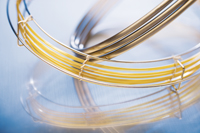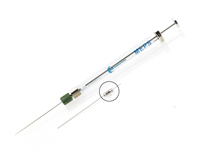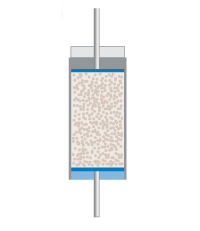
Chromatography
Rt-yDEXsa
(2,3-di-acetoxy-6-O-tert-butyl dimethylsilyl gamma cyclodextrin doped into 14% cyanopropylphenyl/86% dimethyl polysiloxane)
 By adding ß or y cyclodextrin to the bonded Rtx®-1701 stationary phase, we greatly enhance overall utility and column lifetime for the chiral columns, compared to columns that have pure cyclodextrin stationary phases. Separations of more than one hundred chiral compounds have been achieved using our unique DEX columns, and our columns continue to demonstrate stability after hundreds of temperature program cycles. Refer to the applications section of this catalog for examples, or call our Technical Service chemists for assistance in matching a column to your chiral analysis.
By adding ß or y cyclodextrin to the bonded Rtx®-1701 stationary phase, we greatly enhance overall utility and column lifetime for the chiral columns, compared to columns that have pure cyclodextrin stationary phases. Separations of more than one hundred chiral compounds have been achieved using our unique DEX columns, and our columns continue to demonstrate stability after hundreds of temperature program cycles. Refer to the applications section of this catalog for examples, or call our Technical Service chemists for assistance in matching a column to your chiral analysis.
Applications
-
Larger organic molecules
- Flavour compounds in fruit juices
| ID (mm) | df(µm) | Temperature limits (°C) |
|---|---|---|
| 0.25 | 0.25 | 40 to 230 |
| 0.32 | 0.25 | 40 to 230 |
Rt-ßDEXcst
(Proprietary cyclodextrin material doped into 14% cyanopropylphenyl/86% dimethyl polysiloxane)
 By adding ß or y cyclodextrin to the bonded Rtx®-1701 stationary phase, we greatly enhance overall utility and column lifetime for our chiral columns, compared to columns that have pure cyclodextrin stationary phases. Separations of more than one hundred chiral compounds have been achieved using our unique DEX columns, and our columns continue to demonstrate stability after hundreds of temperature program cycles. Refer to the applications section of this catalog for examples, or call our Technical Service chemists for assistance in matching a column to your chiral analysis.
By adding ß or y cyclodextrin to the bonded Rtx®-1701 stationary phase, we greatly enhance overall utility and column lifetime for our chiral columns, compared to columns that have pure cyclodextrin stationary phases. Separations of more than one hundred chiral compounds have been achieved using our unique DEX columns, and our columns continue to demonstrate stability after hundreds of temperature program cycles. Refer to the applications section of this catalog for examples, or call our Technical Service chemists for assistance in matching a column to your chiral analysis.
Applications
- Barbiturates
- Amphetamine and Methamphetamine
- Lactones
| ID (mm) | df(µm) | Temperature limits (°C) |
|---|---|---|
| 0.25 | 0.25 | 40 to 230 |
| 0.32 | 0.25 | 40 to 230 |
Micro Extraction by Packed Sorbent (MEPS)
 Micro Extraction by Packed Sorbent (MEPS) is a new development in the field of sample preparation by Solid Phase Extraction (SPE). MEPS performs the same function as SPE, but with some significant differencies:
Micro Extraction by Packed Sorbent (MEPS) is a new development in the field of sample preparation by Solid Phase Extraction (SPE). MEPS performs the same function as SPE, but with some significant differencies:
- MEPS works with much smaller sample amount (as small as 10µL) than full scale SPE
- MEPS can be fully automated – the sample processing, extraction and injection steps are performed on-line using the same syringe
- MEPS is applicable to GC and LC
- Significantly reduces the volume of solvents and sample needed
 The MEPS product consists of two parts, the MEPS Syringe and the MEPS Barrel Insert and Needle Assembly (BIN). The BIN contains the SPE phase, and is built into the syringe needle. The BIN is used with a 100µL or 250µL gas tight MEPS syringe that allows fluid handling at normal SPE pressures. When the BIN is exhausted, or another phase is required, the BIN is easily exchanged by simply unscrewing the locking nut and removing/replacing the BIN.
The MEPS product consists of two parts, the MEPS Syringe and the MEPS Barrel Insert and Needle Assembly (BIN). The BIN contains the SPE phase, and is built into the syringe needle. The BIN is used with a 100µL or 250µL gas tight MEPS syringe that allows fluid handling at normal SPE pressures. When the BIN is exhausted, or another phase is required, the BIN is easily exchanged by simply unscrewing the locking nut and removing/replacing the BIN.
Rt-MSieve 13X Plot columns
(Molecular sieve 13X)
The Rt™-Msieve 13X PLOT columns are designed for sensitive and fast analysis of gases and light hydrocarbons.
Application
- Hydrocarbon gases
- Permanent gases
| ID (mm) | df(µm) | Temperature limits (°C) |
|---|---|---|
| 0.53 | 20.0 | to 300 |
Rtx-Biodiesel TG
 Available with gard column for extented life time, conected by leak-free Alumaseal™ connector.
Available with gard column for extented life time, conected by leak-free Alumaseal™ connector.- Low column bleed at high temperatures.
- For glycerine and glyceride analysis, according to ASTM D6584 and EN 14105 methods.
Applications
- Biodiesel oil
| ID (mm) | df(µm) | Temperature limits (°C) |
|---|---|---|
| 0.32 | 0.10 | to 330/380 |
Rt-PAH
(proprietary liquid crystalline phase)
- Specially designed for the analysis of polycyclic aromatic hydrocarbons (PAHs) listed in US EPA methods 610 and 8100.
- Compatible with MSD.
The stationary phase of this column is specially designed for separation of isomeric polynuclear aromatic hydrocarbons. Specifically, it provides fast analysis of EPA Method 610 PAH mixture. The stationary phase is cross-linked and chemically bonded, which dramatically lowers the bleed at elevated temperatures, making the column compatible with MS detector.
Applications
- PAHs
| ID (mm) | df(µm) | Temperature limits (°C) |
|---|---|---|
| 0.25 | 1.40 | 80 to 285 |
Rtx-1614
(Optimalized 5% phenyl methyl phase)
- Higher sensitivity and inertness for BDE-209 mean more accurate, reproducible results.
- Meets all EPA Draft Method 1614 requirements for resolution, tailing factors, and retention.
- Unique deactivation, ideal for routine screening of polybrominated diphenyl ethers.
Application
- Polybrominated diphenyl ethers
| ID (mm) | df(µm) | Temperature limits (°C) |
|---|---|---|
| 0.25 | 0.10 | -60 to 330/360 |
RT®-S-BOND Plot Column
(divinyl benzene 4-vinylpyridine)
- Not moisture sensitive.
- Intermediate polarity phase.
- Use for the analysis of nonpolar and polar compounds.
Restek chemists have developed a new process for the manufacturing of porous polymer PLOT columns. The process incorporates the particles to the walls of the tubing, so there is virtually no particle generation. Because of the particle adhering to the walls of the tubing, there is reproducible performance from column to column, including selectivity and flow.
Application
- Analysis of solvent mixture
| ID (mm) | df(µm) | Temperature limits (°C) |
|---|---|---|
| 0.32 | 10.0 | to 250 |
| 0.53 | 20.0 | to 250 |
Rt-Alumina BOND PLOT Columns (deactivated by Na2SO4)
(Aluminium oxid deactivated by Na2SO4)
- Highly selective adsorbent for C1-C5 hydrocarbons; separates all unsaturated hydrocarbon isomers at temperatures far above ambient.
- Reactivity of aluminum oxide stationary phase is minimized so that column response for polar unsaturates, such as dienes, is optimized. Column sensitivity or response ensures a linear and quantitative chromatographic analysis for these compounds.
- Strong bonding prevents particle generation. The column can be used in valve switching operations, without release of particles that can harm the injection and detection systems.
- The Rt™-Alumina PLOT column is stable up to 200°C. If water is adsorbed on the column, it can be regenerated by conditioning at 200°C. Full efficiency and selectivity will be restored.
Selectivity
The selectivity of the Rt™-Alumina PLOT column is measured by the retention indices for acetylene and propadiene. These two components are extremely sensitive for a change in selectivity.
For saturates, retention is determined mainly by the volatility of the compound, with less volatile compounds retained longer than more volatile compounds. For example, isoparaffins are less retained than less volatile normal paraffins of similar carbon number.
For unsaturates, retention is strongly influenced by polarity or degree of unsaturation. In general, hydrocarbons having a higher degree of unsaturation are more polar. This polarity comes from the presence of π electrons; the more π electrons present in a compound, the more polar it behaves and the more strongly it is retained.
Sensitivity
Proper deactivation is critical to minimize reactivity of the aluminum oxide stationary phase and maximize column sensitivity. Quantitation can be done only if the column exhibits linear response, which results from good stationary phase inertness. Rt™-Alumina PLOT columns are specially deactivated and provide high inertness for unsaturates and saturates. In fact, Rt™-Alumina PLOT columns are almost four times more sensitive for unsaturates than other brands on the market.
Guaranteed Reproducibility
Each Rt™-Alumina PLOT column is tested with a hydrocarbon test mix to ensure proper phase thickness and deactivation (see figure). Pentane is used to calculate k (capacity factor), which is a measure of phase thickness. The ratio of isobutane to acetylene retention is measured to ensure proper deactivation of the alumina oxide layer. The plates per meter value is calculated to evaluate column efficiency.
Restek’s Rt™-Alumina PLOT columns offer fast and reproducible hydrocarbon stream and purity analyses. The 0.32mm ID Rt™-Alumina PLOT column provides fast and efficient analysis of C1 to C5 hydrocarbons. The higher capacity of the 0.53mm ID Rt™-Alumina PLOT column makes it ideal for purity analysis of many common petrochemicals, such as 1,3-butadiene, ethylene, and propylene.
Application
- C1 - C5 hydrocarbons
- Purity analysis of ethylene, propylene, butenes, butadiene
| ID (mm) | df(µm) | Temperature limits (°C) |
|---|---|---|
| 0.32 | 3.00 | to 200 |
| 0.53 | 6.00 | to 200 |
Rt®-Q-BOND PLOT Column
(100% divinylbenzene)
- Not moisture sensitive.
- Non polar phase.
- Excellent for analysis of C1 to C3 isomers and alkanes up to C12.
- CO2 and methane separated from O2/N2/CO (Note: O2/N2/CO not separated at room temperature).
- Use for analysis of oxygenated compounds and solvents.
Restek chemists have developed a new process for the manufacturing of porous polymer PLOT columns. The process incorporates the particles to the walls of the tubing, so there is virtually no particle generation. Because of the particle adhering to the walls of the tubing, there is reproducible performance from column to column, including selectivity and flow.
Application
- Subambiente analysis of Permanent gases
- Hydrocarbon gases
- Solvents
| ID (mm) | df(µm) | Temperature limits (°C) |
|---|---|---|
| 0.32 | 10.0 | to 320 |
| 0.53 | 20.0 | to 320 |





 0
0
 0
0